
Our review camera for today is the compact Minolta Freedom III; featuring a quartz date back, AF, auto loading, advance and rewind; along with a nice 35mm F/2.8 lens. The ‘Freedom’ line from Minolta were wildly popular during the 1980s, and competed with the similar Canon and Nikon offerings of the day. This camera came out in 1986 along with three other ‘Freedom’ models; see a goofy wild west themed period ad here.
The fully automatic Minolta Freedom III (AF-Z) was at the top of the Freedom line, and fairly expensive back in the day. So will it still take good pictures today? Let’s find out now!
Name; Minolta Freedom III Quartz Date; also known as ‘AF-Z” in Europe, and “MAC-7’ in Japan.
Box contents; camera, owner’s manual, a wrist/neck strap and maybe a vinyl carrying case.
Manufactured by; Minolta Co, LTD, Osaka, Japan.
Made in: Japan.
Date of manufacture; 1986-?
Price; retail probably around $250-300. Current ebay prices are around $25-50 for a good used copy. I paid a paltry $7 for this copy, which was part of a large lot of cameras I purchased on ebay.
Build material; mostly plastic body.
Weight; camera with batteries, 12.1oz (344g).
Dimensions; Size is 5.35″ (136mm) wide, 2.8″ (72mm) high, and 1.8″ (45mm) deep.
Focal length; 35mm.
Aperture; F/2.8-18, not user selectable.
Focusing; active type infrared auto focus, 2.1′ (0.65m) to infinity.
Original print size; standard over-sized prints 4 x 6.″
Approximate resolution; will make excellent 5″x 7,” and very good 8″x 10″ prints.
Lens; 35mm F/2.8 multi-coated glass four elements in four groups design. Angle of view 63°
Shutter and speed; 1/40s to 1/800s but not user adjustable. No cable release option.
Distortion; did not check, but looks mild from the pictures I have with straight lines near the edges.
Color fringing; mild magenta colored lateral type.
Double exposure prevention; yes, but cannot be over-ridden.
Features; fill flash, 10 second timer, sequential (1 shot per second) mode.
Film; all 135 film cartridges, B&H, Amazon, eBay.
Flash. built in, 13′ (4m) at ISO 100, 1.2 second recharge time with fresh lithium batteries or pack.
Power; DL223A 6V or 4 AAA batteries for main power, and a CR2025 for the data back. The owner’s manual states the camera has a built-in lithium battery that lasts for 10 years. I don’t know what the battery is for, or where it is.
Viewfinder; .6x magnification. Small, with good brightness, marks for framing with parallax correction, and AF zone. Has red and green warning lights. Solid green means you’re good to shoot, blinking green (ISO 200 or less) means subject is beyond flash range. Solid red means flash is charging; there is no blinking red warning.
DX coding; 25-1600. Defaults to ISO 100 when no code is detected.
Accessories for this model; Close-up lens and tele photo lens from Minolta.
Crippling features and omissions; no way to shut off flash, but you can put your finger over the strobe lens if you don’t want the flash illuminating your picture. Uses expensive 6V battery, but can use four AAA too.
Good features; very simple to operate, excellent exposures, fast and mostly accurate AF, and decent flash.
Go here for an owner’s manual, and be sure and tip the site owner.
Product shots with descriptions. Click for larger images.
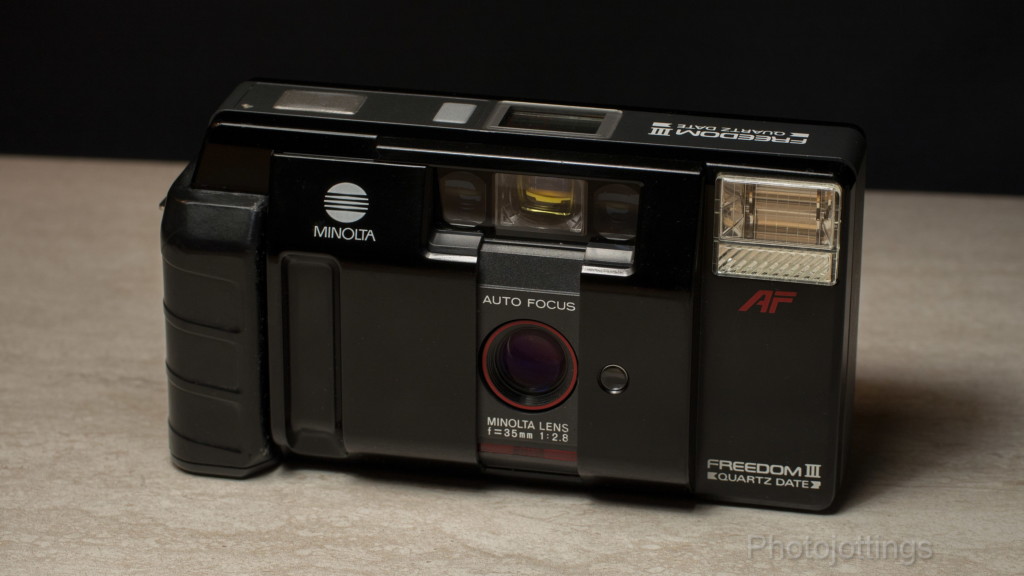
The power turns on automatically when the lens cover slides open to the users right. The three windows above the lens are as follows; in the center is the viewfinder, the smaller windows to the left and right are used for AF. The little round window to the right of the lens is the metering cell.

Along the top plate is a small rectangular LCD that shows the shot count, and four different modes. Default is ‘normal’ mode, then self timer, fill flash, and ‘sequential.’ In sequential mode, you can press and hold the shutter button and it fires off shots at about one per second. The LCD also shows when film is winding/rewinding and whether film is loaded.
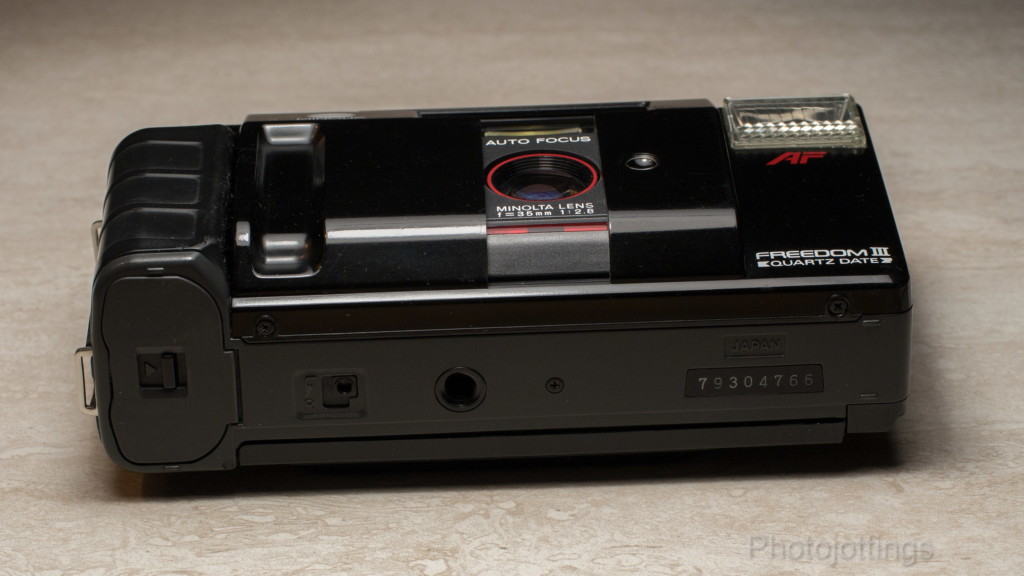
The battery compartment is on the left. The little square sliding switch is for manual early rewinding only, the camera will automatically rewind at the end of the roll. A ¼-20 tripod socket is provided, but probably not needed as the lowest shutter speed is 1/40s. However, it may be helpful for getting yourself in the shot if no one is available to help out.
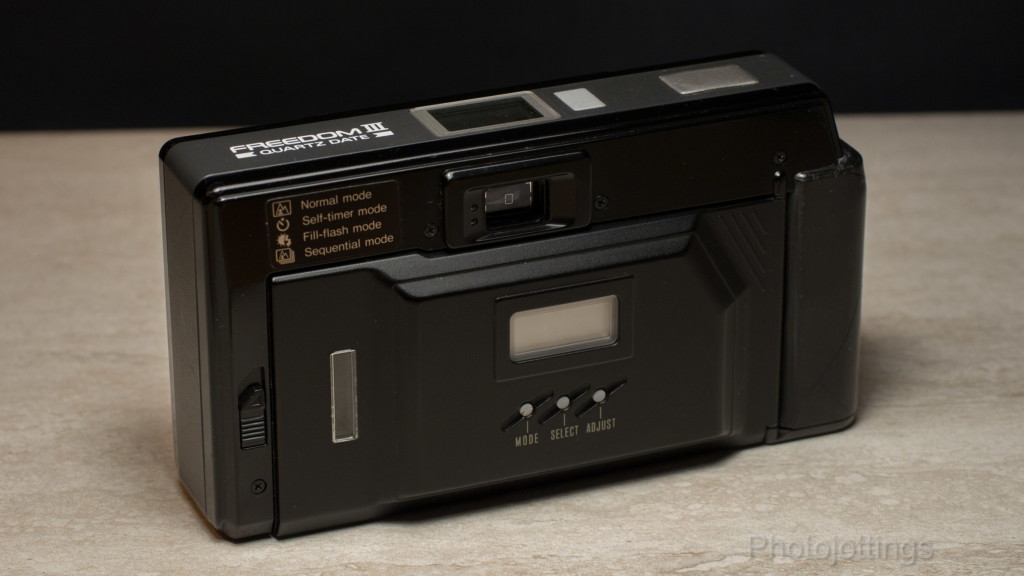
This model has the Quartz Date back, and can be set to the correct date using the tiny recessed buttons; I’m not sure if you can set the current year or not. The data back uses a CR2025 3V coin battery that’s located inside the back cover.
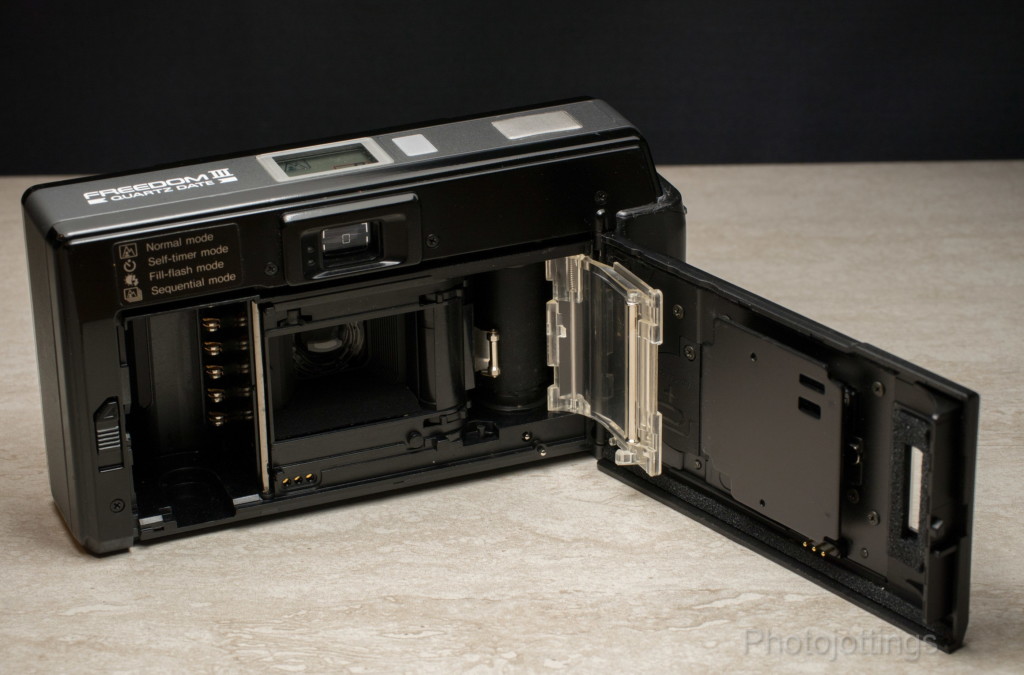
A look at the inside of the camera. The clear plastic ‘door’ is a ‘film threader’ and when closed, the film advances a small amount, and then continues to shot no. 1 when the rear cover is closed.
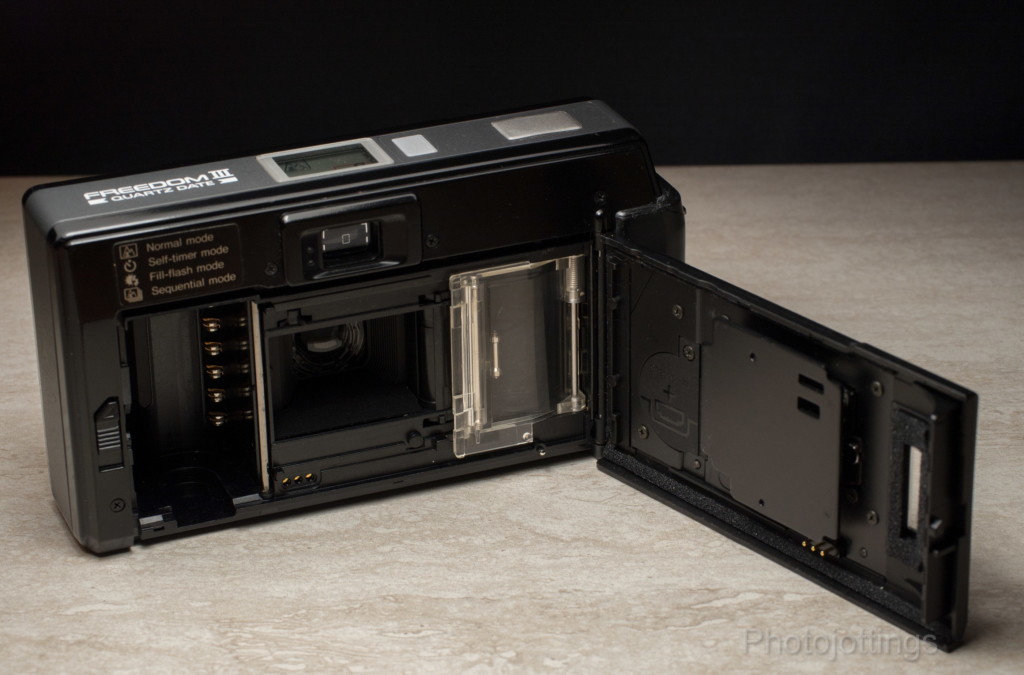
The ‘film threader’ door closed. The coin cell date back battery cover is located along side the pressure plate on the rear cover.
Here are some bad test images scanned on a Nikon Super Coolscan 9000 ED. All are 3300 pixels wide; there is no additional resolution from scanning at a higher sample rate. Kodak Gold 200 used for all shots. Click for larger images.

Geometric home front.
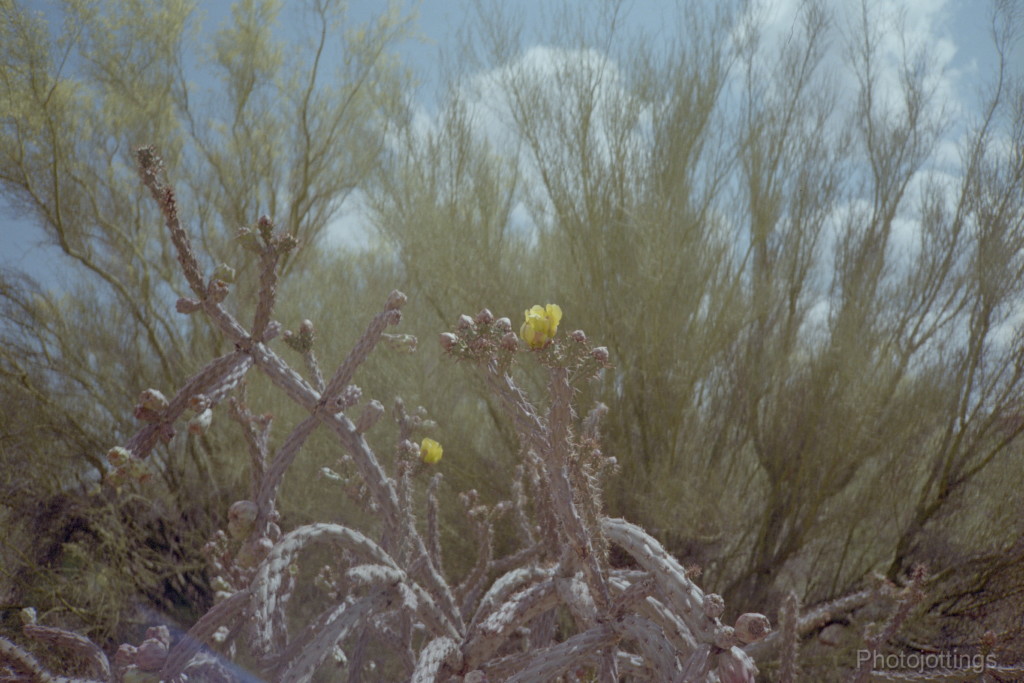
Close focus; around 3′ or 1m. Probably stopped down to F/8 or so based on the lack of decent background blur. Slight blue arc ghosting at lower left corner.
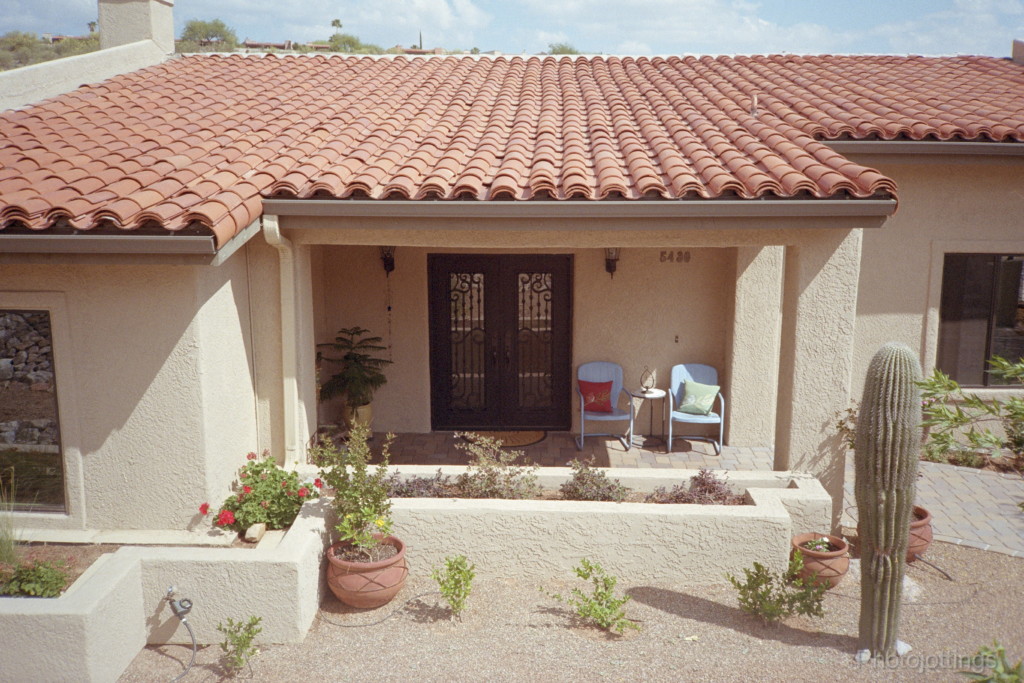
Lens distortion along the roof line is not noticeable.
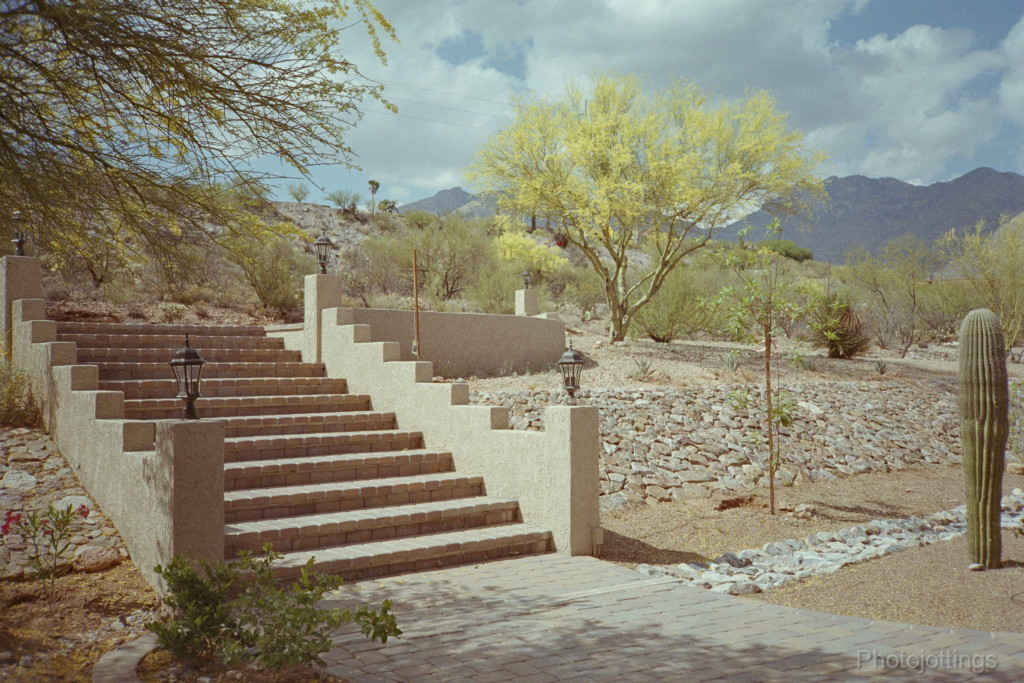
Stairway to nothing; notice smudged extreme corners.
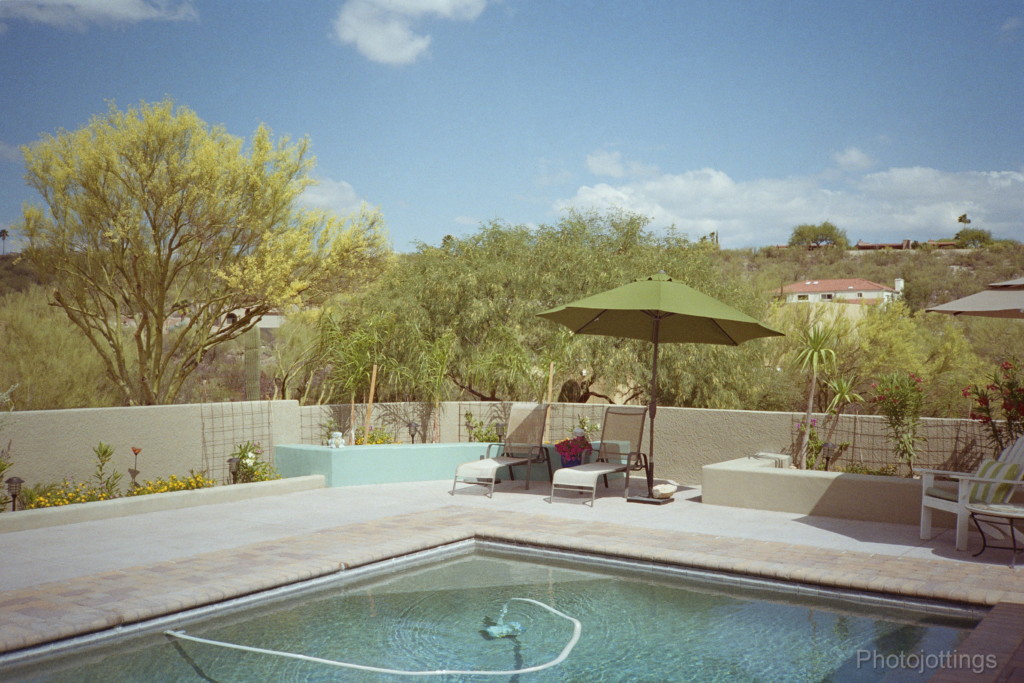
A pretty ool scene, let’s keep the ‘p’ out of it.
Conclusion.
The Minolta Freedom III (or AF-Z) is an easy camera to get good pictures from; there’s really nothing for you to do other than point and shoot. From my limited use thus far I noticed the AF is fast and accurate; in fact I had no outdoor pictures that were focused incorrectly, and only one inside picture of a small room that was out of focus. With that said, I did notice that if you get closer than the minimum 2.1′ (0.65m) the green in-focus light still glows; but your shot will be blurry.
The metering system seems outstanding, however, that’s an easy task when using print film as I’ve done here, but I didn’t test any slide film which requires more careful metering for correct exposures. I’ve used Kodak Gold 200 for the shots above, which is good film for the price, but not my favorite because of the colors and shadows; I’d look to Ektar or Portra for better colors and grain, especially in the shadows.
The four element lens is quite sharp with good contrast, even along the sides; however, the extreme corners are smudged as you can see in the pictures above, but it doesn’t bother me.
I like the little Minolta Freedom III so much that I’m going to run more film through it, along with testing out some of the Minolta lens converters and see what happens. Stay tuned for an update!
That’s it for this review, thanks for visiting!
Please consider buying your goodies through my links, doing so helps support the site, thanks!